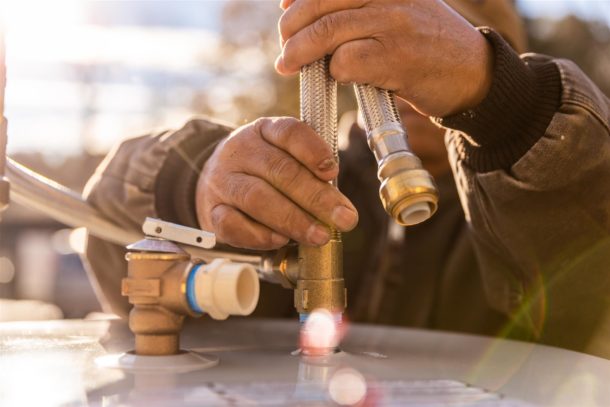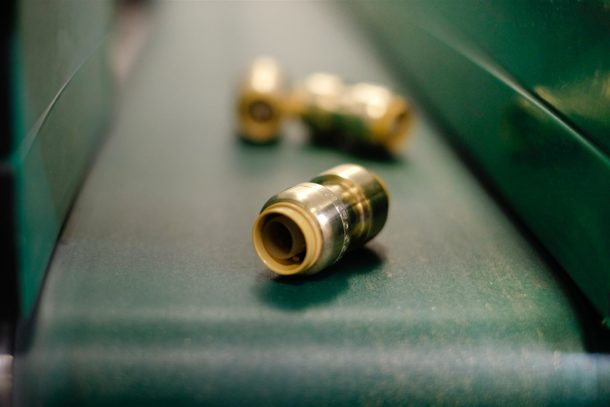Washington — The IAPMO Group and Plumbing Manufacturers International (PMI) applaud the House Science, Space and Technology Committee for advancing legislation this past week reauthorizing the National Institute of Standards and Technology and calling for the creation of a program for premise plumbing research. During the July 27 committee mark-up of the bill, U.S. Rep Read more
IAPMO
Washington — The IAPMO Group and Plumbing Manufacturers International (PMI) applaud the House Science, Space and Technology Committee for advancing legislation this past week reauthorizing the National Institute of Standards and Technology and calling for the creation of a program for premise plumbing research.
During the July 27 committee mark-up of the bill, U.S. Rep. Paul Tonko (D-N.Y.) was successful in offering an important amendment to H.R. 4609, the National Institute of Standards and Technology for the Future Act of 2021, that would authorize funding at NIST to conduct practical, water-related research on systems within homes and buildings, addressing critical issues such as water quality, efficiency, reuse, sustainability and resilience.
A new program at NIST will help to combat a 900% increase in Legionnaires’ disease since 2000. Legionnaires’ disease is an infection caused by the bacteria Legionella. Symptoms of the disease include fever, cough and pneumonia, while a milder infection can look like a flu-like illness without pneumonia. The sickness can be deadly in older patients or those with other risk factors. Reports of the infection are more common in the summer and early fall when warming, stagnant waters present the best environment for bacterial growth in water systems. News articles from across the country detail the prevalence of this public health challenge.
From the exponential growth of Legionnaires’ disease outbreaks to increasing housing affordability, the industry is waiting and ready to apply the findings of this research to tackle major issues,” said IAPMO CEO Dave Viola. “We applaud Rep. Tonko and other committee members for recognizing this need and including it in this important piece of legislation. This will have a direct, positive impact on America’s homes and buildings today and for the foreseeable future.”
Over the years, IAPMO and PMI have worked with Congress and NIST to address and prioritize research needs on plumbing. Rep. Tonko’s amendment is based on legislation developed by Rep. Matt Cartwright (D-PA) and Sen. Tammy Duckworth (D-IL), who have both previously introduced legislation to expand NIST’s efforts on drinking water. In May 2020, NIST published a report that identified nearly 60 specific research needs and challenges faced by the plumbing industry. This report provides a useful roadmap for addressing those needs through applied research and codes and standards activities.
Kerry Stackpole, PMI CEO, said that “American consumers have the benefit of state-of-the-art water efficient plumbing fittings and fixtures; however, the legacy plumbing that carries water to these fixtures in our homes and offices are based on research and data from the 1930s.” Stackpole noted that “updated research and data by NIST, in conjunction with academia, industry and other key stakeholders, would significantly improve the water efficiency and safety in water systems across the nation.”
Another important issue that will be addressed by NIST research is the sizing of plumbing systems in buildings. Much has changed in the way Americans use water since the 1920s and ’30s when Dr. Roy Hunter, working for the National Bureau of Standards, the predecessor to NIST, developed the method for predicting water use demands in a building and determining how large systems need to be to accommodate those demands. While minor updates have been made over the years to these methods, they are still used today in plumbing codes despite the many improvements and efficiencies made to plumbing fixtures, appliances and other water-using equipment in subsequent years. As a result, it is widely recognized that today’s plumbing systems are often grossly oversized, resulting in increased building costs, wasted water and energy, and declining water quality. The research will seek to resolve this problem and lead to a method for determining plumbing system sizes that are more appropriate for the particular building.
St. Paul, Minn. — The state of Minnesota has formally adopted the 2018 edition of IAPMO’s Uniform Plumbing Code (UPC®), with state-specific amendments, to form the 2020 Minnesota Plumbing Code. It is available for purchase from the IAPMO Online Store at https://iapmomembership.org/store/2020-minnesota-plumbing-code/1126/. As Chapter 4714 of the Minnesota State Building Code, it will be enforced as Read more
St. Paul, Minn. — The state of Minnesota has formally adopted the 2018 edition of IAPMO’s Uniform Plumbing Code (UPC®), with state-specific amendments, to form the 2020 Minnesota Plumbing Code. It is available for purchase from the IAPMO Online Store at https://iapmomembership.org/store/2020-minnesota-plumbing-code/1126/. As Chapter 4714 of the Minnesota State Building Code, it will be enforced as law effective Dec. 17.
Some of the key updates to the Minnesota Plumbing Code include:
- New sound transmission provisions for plumbing piping systems. New provisions for trenching excavation and backfill, rehabilitation of piping systems, and Schedule 40 PVC and ABS DWV and storm pipe expansion table (Chapter 3)
- New product standards for plumbing fixtures such as wall hung fixtures, waste fittings, lavatories, showers, bathtubs and whirlpool bathtubs, flushometer valves, sinks and eyewash stations; and signage for single-use toilet facilities (Chapter 4)
- New backflow protection provisions for chemical dispensers, new material provisions for pipes, tubes, fittings and joint methods for water supply and distribution, piping insulation, and new pressure testing for the hot- and cold-water supply system (Chapter 6)
- New material requirements for drain, waste, vent pipe and fittings (Chapter 7)
- New provisions for condensate waste and control (Chapter 8)
- Circuit venting (Chapter 9)
- Methods of testing storm drainage systems (Chapter 11)
- Updated ASSE Series 5000 testing procedures
- Appendix I — Installation standard for PEX tubing systems for hot- and cold-water distribution
- New Useful Tables
Also new to the UPC in 2018 is Appendix M, Water Demand Calculator (https://www.iapmo.org/water-demand-calculator/), representing the first major update to plumbing sizing requirements since the 1940s and giving plumbing professionals the opportunity to see firsthand how IAPMO is committed to developing new provisions toward improving water quality and safety, reducing construction costs, and saving consumers energy, water and money. The Water Demand Calculator predicts peak water demand for single- and multi-family dwellings when water efficient fixtures are installed. An independent study found notable cost savings when applied to residential structures.
The UPC was introduced in Los Angeles in 1928 and formally published as the Uniform Plumbing Code in 1945. It is developed using IAPMO’s consensus development procedures accredited by the American National Standards Institute (ANSI). This process brings together volunteers representing a variety of viewpoints and interests to achieve consensus on construction practices. Developed and subsequently republished at the conclusion of each three-year code cycle, the Uniform Codes are designed to provide consumers with safely functioning systems while, at the same time, allowing latitude for innovation and new technologies.
Mokena, Ill. — ASSE 1090-2020, Performance Requirements for Drinking Water Atmospheric Water Generators (AWG), has been designated as an American National Standard by the American National Standards Institute (ANSI) and is now available for purchase. ASSE 1090 was created to test point of use and commercial drinking water generating devices, which are designed to create Read more
Mokena, Ill. — ASSE 1090-2020, Performance Requirements for Drinking Water Atmospheric Water Generators (AWG), has been designated as an American National Standard by the American National Standards Institute (ANSI) and is now available for purchase.
ASSE 1090 was created to test point of use and commercial drinking water generating devices, which are designed to create potable water from atmospheric humidity. Critical components of these devices include a condenser, storage tank, and filtration/disinfection controls to address potential chemical, particulate, and microbiological water contamination. The standard also includes consideration for the energy efficiency of the AWG.
ASSE 1090 started its life as ASSE LEC 2004-2019, Listing Evaluation Criteria for Drinking Water Treatment Systems Using Air as a Source. ASSE International Listing Evaluation Criteria (LEC) documents provide manufacturers with an avenue to certify unique, novel products that do not fit the scope of an existing standard. If these products gain traction and market acceptance, the LEC can then be developed into an ASSE Standard through the ANSI-accredited standards development process. ASSE 1090 is one example of an LEC that has gone through the process of becoming an ASSE American National Standard.
With AWG products, water-from-air becomes a real source of water supply in places where tap water is not available, or the quality of the tap water does not meet the consumer’s requirements. Creating a product performance standard to help ensure that these products produce safe, potable water was desired by the water treatment industry.
“Standards legitimize an industry and should also make it easier to assess solution providers,” said Frank A. Brigano, Ph.D., ASSE 1090 Working Group Member and Vice President, Senior Research Fellow, at Marmon Water, a division of Berkshire Hathaway. “The beauty of AWG systems is that they are disconnected from municipal systems and their inherent ‘issues.’ Thus, making claims of ‘free from heavy metals and organics, worry-free from boil water warnings, PFAS, etc.,’ is what makes these systems attractive.”
To become a source of drinking water under this standard, the water-from-air should meet two primary criteria:
1) The water should be produced for a reasonable cost so that it’s affordable to the user. The cost of the water is based on the energy efficiency of the atmospheric water generator system — electrical energy consumption per liter of water produced.
2) The water quality produced by the atmospheric water generator must be safe to consumers.
To purchase ASSE 1086, please visit the ASSE International Webstore at www.assewebstore.com.

When looking for a new plumbing product, what’s most important? For many, the decision comes down to whether the product works and is affordable – and rightly so. But to maximize your investment and ensure the job’s success long after you leave the jobsite, it’s important to dig deeper into the products you use and Read more
When looking for a new plumbing product, what’s most important? For many, the decision comes down to whether the product works and is affordable – and rightly so. But to maximize your investment and ensure the job’s success long after you leave the jobsite, it’s important to dig deeper into the products you use and the manufacturer that creates them.
And once you find plumbing manufacturers you trust, you’ll have more confidence in your installs and worry less about customer callbacks. It may sound tedious to research manufacturers, but the payoff — knowing they’re reliable — is worth the extra time.

So, how do you find trustworthy manufacturers? Start by asking the right questions:
Does the manufacturer have a proven track record of reliability?
Having a new product fail after installation isn’t a gamble any contractor wants to take. It should be a given that it was built to last.
When you install a product, you need to know it won’t fail. A reliable manufacturer ensures quality throughout production and creates products to comply with industry codes and standards.
This happens by:
- Choosing quality materials over cheaper materials.Instead of using lower-quality raw materials to save money, the manufacturer should use robust materials that last long after installation. And its product specs should be easy to find online to maintain transparency about the product.
- Performing rigorous independent testing.Each product should undergo months of repetitive and extreme testing to make sure it can be pushed to its limits without failing. Try to find what a manufacturer has to say about their testing process — and if it exceeds minimum testing requirements.
- Helping lead compliance initiatives.Manufacturers shouldn’t just produce products that comply with industry standards. Company leaders should participate in initiatives promoting safer products that are better for the environment, such as the IAPMO WE Stand Committee.
- Owning the manufacturing process. Manufacturers who own the production of their products from raw material to final product have more control over the product quality and when things need to be adjusted.
Does the manufacturer create products that work seamlessly with existing solutions?
As a contractor, it’s a must that new products can work well with the ones you already use. It’s the manufacturer’s responsibility to make sure their solutions complement not only those in the same product line but also ones from different brands and materials.

Does the manufacturer’s leadership spend time on the jobsite?
Manufacturers should constantly seek ways to improve plumbers’ jobs, and the only way to truly do that is to walk alongside them on the jobsite. The manufacturers you partner with should be asking about your biggest pain points and presenting real solutions.
And even if you’re not yet one of their customers, the manufacturer should make it clear how they support and communicate with contractors like yourself. Look for evidence of strong customer relationships by reading online reviews, testimonials, case studies and support pages.
Partnering with the Right Manufacturers
The next time you search for a new plumbing product, take time to consider the reputation and business practices of the manufacturers. You’ll end up with more reliable products that will, in turn, help boost your own reputation with your customers.
 Chris Carrier is the Marketing Director, Americas at RWC – a market leader and manufacturer of water control systems and plumbing solutions for residential and commercial applications.
Chris Carrier is the Marketing Director, Americas at RWC – a market leader and manufacturer of water control systems and plumbing solutions for residential and commercial applications.
Mokena, Ill. — The International Association of Plumbing and Mechanical Officials (IAPMO), in conjunction with Special Pathogens Laboratory (SPL), is offering an ASSE 12080 LegionellaWater Safety and Management Specialist Certification Training program, Aug. 17-19. SPL President Janet Stout, Ph.D., a clinical and environmental biologist with more than 30 years of pioneering research in Legionella, will teach Read more
Mokena, Ill. — The International Association of Plumbing and Mechanical Officials (IAPMO), in conjunction with Special Pathogens Laboratory (SPL), is offering an ASSE 12080 LegionellaWater Safety and Management Specialist Certification Training program, Aug. 17-19.
SPL President Janet Stout, Ph.D., a clinical and environmental biologist with more than 30 years of pioneering research in Legionella, will teach the three-day course. The speakers will include David Pierre, vice president of SPL Consulting Services, and Michael Castro, MPH, SPL’s director of Healthcare Services.
“This training provides the critical knowledge that industry professionals need to prevent this life-threatening disease,” Stout said. “At completion, attendees meet the knowledge requirements for the very first Legionella professional qualifications standard [ASSE 12080]. IAPMO’s expertise in education and training, together with Special Pathogens Laboratory, provides participants with the knowledge they need to become an ASSE certified professional for Legionella water safety and management, getting us closer to ending Legionnaires’ disease!”
Attendees will gain the requisite knowledge, understanding, and competency to serve as a member of a facilities water safety team to help protect against Legionella outbreaks and react to one appropriately should it occur. The program will focus on the development of a risk assessment analysis, and water management and sampling plan, for protection from Legionella and other waterborne pathogens. The training will also cover the codes, and the resources, understanding, and skills needed to conduct a facility risk assessment and implement a water safety and management program to reduce the risk of infections due to Legionella.
“By partnering with Special Pathogens Laboratory, both organizations have been able to complement each other’s strengths in order to create a much-needed training and certification program,” said Tony Marcello, IAPMO’s vice president of Training and Credential Services. “We are very excited about the difference this program can make in protecting the health and safety of building occupants as well as helping those who own and manage facilities lower their liability risks.”
The ASSE 12080 certification exam will be administered at the end. Attendees who pass the exam will become certified as Legionella Water Safety and Management Specialists.
The training program is scheduled for 8 a.m.-5 p.m. Aug. 17-19 at the UA Local 130 Training Center, 1400 W. Washington Blvd., Chicago. The registration fee includes the ASSE exam, the SPL workbook Puzzled by Legionella? A Guide to Understanding Detection, Prevention, and Water Management, and lunch. To register, visit https://www.iapmolearn.org/topclass/searchCatalog.do?catId=129117.
For information about the ASSE 12080 standard, visit https://bit.ly/31dzNoQ.
